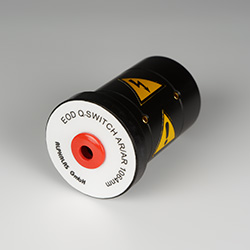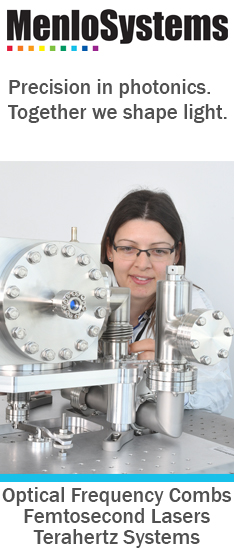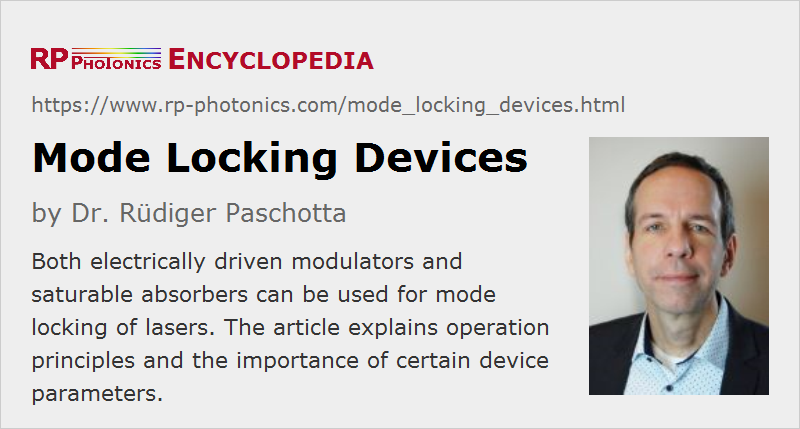Mode Locking Devices
Definition: devices for achieving mode locking of a laser
Alternative term: mode lockers
More specific terms: optical modulators, saturable absorbers
German: Modenkoppler, Komponenten für das Modenkoppeln von Lasern
Categories:  laser devices and laser physics,
laser devices and laser physics,  light pulses
light pulses
Author: Dr. Rüdiger Paschotta
Cite the article using its DOI: https://doi.org/10.61835/44i
Get citation code: Endnote (RIS) BibTex plain textHTML
Using some kind of mode locking device (or mode locker), a laser can be forced into the operation regime of mode locking, where it emits a regular train of ultrashort pulses. For active mode locking, one requires some kind of intensity modulator or phase modulator which is inserted into the laser resonator. For passive mode locking, one uses a saturable absorber.
Modulators for Active Mode Locking
In most cases, an intensity modulator is used, which is operated with a sinusoidal drive signal, the frequency of which matches the round-trip frequency of the laser resonator and the pulse repetition rate of the output. (In the case of harmonic mode locking, the drive frequency is an integer multiple of the round-trip frequency.) Typically, one uses an electro-optic modulator, but for mode-locked diode lasers electroabsorption modulators can also be a good choice. Another possibility is the use of an acousto-optic modulator with a frequency-modulated drive. In a linear resonator, the modulator should be placed close to an end mirror.
Essentially, the function of the active mode locker is the following (assuming the use of an intensity modulator):
- The circulating pulse passes the modulator at those times where it experiences minimum loss. Due to the sinusoidal loss modulation, the temporal wings of the pulses experience slightly higher losses. This leads to a slight temporal compression effect, which in the steady state of the laser can compensate for temporal broadening effects, for example from the limited gain bandwidth of the gain medium.
- In case that there is a slight timing error of the circulating pulse, the modulator creates a “restoring force”, which tends to “pull it back”.
- The modulator suppresses any other light circulating in the resonator because while the net round-trip gain for the circulating pulse is zero in the steady state (by gain saturation), the higher losses at other times lead to a negative net round-trip gain for other light.
A higher modulation depth helps to obtain a shorter pulse duration, but this influence is quite weak, as explained by Kuizenga–Siegman theory. The tolerance for a resonator length mismatch is also somewhat increased with a higher modulation depth.
It is also possible to use a phase modulator, although it is somewhat more difficult to understand how that can induce mode locking.
The modulator should not cause any parasitic reflections remaining in the beam path. Surfaces which are exactly perpendicular to the beam path should therefore be avoided.
The insertion loss should of course be as small as possible in order to maintain a good power conversion efficiency of the laser.
Modulator Drivers
Essentially, a modulator driver only needs to produce a sinusoidal drive signal with the correct frequency and an appropriate amplitude for connection to the modulator. However, one usually requires some kind of feedback loop to ensure long-term synchronism between the drive signal and the resonator's round-trip time. There are essentially two different possible realizations for that feedback loop:
- One may fine-tune the resonator length with piezo actuator, which is for example placed in the mount of a laser mirror. The laser may then work with an externally given drive frequency, which however can usually be varied only within a small range.
- Instead, one may tune the drive frequency. Tuning of the repetition rate is then possible by modifying the resonator length.
In any case, one needs to generate an error signal, telling the feedback electronics in which way to modify the resonator length of the drive frequency. That can be done based on a signal from a fast photodiode exposed to some beam split from the output beam, or alternatively using some parasitic transmission of a highly reflecting resonator mirror. The method is called regenerative feedback.
Saturable Absorbers for Passive Mode Locking
Real Absorbers
For passive mode locking, one uses a saturable absorber in the laser resonator, which is in most cases a reflective device inserted as an end mirror of the resonator. The essential functions of that absorber are the following:
- It needs to initiate the mode locking. Usually, immediately after turn-on the laser will be in continuous-wave operation with some amount of intensity noise. The saturable absorber will always favor the most intense part of the circulating radiation and eventually let only a single pulse “survive”, typically only after thousands of resonator round trips.
- In the simpler case of a “fast” absorber, having a recovery time well below the pulse duration, both the leading and trailing temporal wing of the pulse are attenuated, leading to a pulse shortening effect similar to that of an active modulator. However, the loss modulation is much faster, since it is driven by the pulse itself. Therefore, passive mode locking typically leads to much shorter pulse durations.
- Mode locking can also work well with “slow” absorbers, where the recovery time may be more than 10 times longer than the pulse duration. One may expect stability problems due to positive net gain “behind” the circulating pulse, but in fact stability is given if the recovery time is not too long [7].
- An absorber also suppresses light circulating at other times, which (as long as it is weak enough) cannot saturate the absorption and therefore experiences higher power losses.
In most cases, one uses a so-called semiconductor saturable absorber mirror (SESAM) [6] for passive mode locking. Such devices can be tailored for a wide range of operation parameters, and are therefore successfully used for a wide range of mode-locked lasers concerning pulse durations, pulse repetition rates, optical wavelength, output power etc. SESAMs can be used both in solid-state bulk lasers just as end mirrors, and in mode-locked fiber lasers. In the latter case, it is preferable to use a fiber-coupled SESAM, which may either contain a fiber which is simply butted to the semiconductor structure, or a fiber collimator for operation with larger mode area.
Essential parameters of a SESAM for mode locking are the following:
- Operation wavelength: both the contained Bragg mirror and the absorber layer(s) must be suitable for the intended operation wavelengths, so that these devices usually work only within a wavelength range with a width of a few tens of nanometers. For operation in new wavelength regions, a substantial new device development may be necessary, involving new materials, adapted design parameters etc.
- Modulation depth: This is the maximum change of reflectivity due to the absorber saturation. It should be large enough to safely initiate the mode locking and produce short pulses, but not too large, since otherwise one may obtain a reduced power efficiency, absorber damage or Q-switching instabilities.
- Recovery time: This is the time for the saturated absorption to recover to its normal state. Often, it is substantially longer than the pulse duration, but if it is too long, instabilities will result. The obtained pulse duration will often have little dependence on the absorber recovery time.
- Saturation fluence: this together with the beam area determines the saturation energy, which should usually be of the order of a quarter of the circulating pulse energy, or sometimes less.
Some other types of saturable absorbers are also sometimes used for mode locking, e.g. absorbers based on carbon nanotubes [8, 9, 11] or graphene.
Artificial Saturable Absorbers
There are also various kinds of artificial saturable absorbers. These are devices which exhibit decreasing optical losses for higher intensities, but not based on real light absorption. Such devices can be based on e.g.
- Kerr lensing combined with some kind of aperture (→ Kerr lens mode locking) [4]
- a nonlinear mirror device containing a frequency-doubling crystal, as sometimes used for passive mode locking of solid-state bulk lasers [1, 12]
- a nonlinear fiber within an auxiliary resonator (→ additive-pulse mode locking) [2]
- nonlinear polarization rotation in a fiber, combined with a polarizing element, often used for passive mode locking of fiber lasers [5]
- a nonlinear fiber loop mirror, also used for mode locking of fiber lasers [3]
- an array of waveguides, exhibiting nonlinear coupling [10]
Choice and Optimization of Saturable Absorbers
The optimum parameters of a saturable absorber strongly depend on the type of laser and the intended operation regime. The choice of absorber parameters should be based on a comprehensive quantitative understanding of the system because otherwise non-ideal performance parameters or even instabilities can result, in other cases premature absorber degradation or instant destruction. Ideally, one should study the intended operation based on a numerical pulse propagation model.
More to Learn
Encyclopedia articles:
Suppliers
The RP Photonics Buyer's Guide contains 11 suppliers for mode locking devices. Among them:


ALPHALAS
Electro-optic phase or intensity modulators including a driver can be used at frequencies up to 100 MHz for actively mode-locking lasers at various wavelengths. These are manufactured on customer’s demand.
Proprietary electro-optic deflectors (EOD) are also offered as efficient active mode-locking devices.


RefleKron
Our customized semiconductor saturable absorber mirrors (SESAMs) can be used for passive mode-locking of fiber, solid-state and semiconductor lasers, with wavelengths ranging from 620 nm to 3.5 µm.
Contact us for the optimal customized SESAM for your application.
Bibliography
| [1] | K. A. Stankov, “A mirror with an intensity-dependent reflection coefficient”, Appl. Phys. B 45, 191 (1988); https://doi.org/10.1007/BF00695290 |
| [2] | J. Mark et al., “Femtosecond pulse generation in a laser with a nonlinear external resonator”, Opt. Lett. 14 (1), 48 (1989); https://doi.org/10.1364/OL.14.000048 |
| [3] | M. E. Fermann et al., “Nonlinear amplifying loop mirror”, Opt. Lett. 15 (13), 752 (1990); https://doi.org/10.1364/OL.15.000752 |
| [4] | T. Brabec et al., “Kerr lens mode locking”, Opt. Lett. 17 (18), 1292 (1992); https://doi.org/10.1364/OL.17.001292 |
| [5] | M. E. Fermann, “Passive mode locking by using nonlinear polarization evolution in a polarization-maintaining erbium-doped fiber”, Opt. Lett. 18 (11), 894 (1993); https://doi.org/10.1364/OL.18.000894 |
| [6] | U. Keller et al., “Semiconductor saturable absorber mirrors (SESAMs) for femtosecond to nanosecond pulse generation in solid-state lasers”, J. Sel. Top. Quantum Electron. 2, 435 (1996); https://doi.org/10.1109/2944.571743 |
| [7] | R. Paschotta et al., “Passive mode locking with slow saturable absorbers”, Appl. Phys. B 73 (7), 653 (2001); https://doi.org/10.1007/s003400100726 |
| [8] | S. Y. Set et al., “Laser mode locking using a saturable absorber incorporating carbon nanotubes”, J. Lightwave Technol. 22 (1), 51 (2004); https://doi.org/10.1109/JLT.2003.822205 |
| [9] | A. Schmidt et al., “Passive mode locking of Yb:KLuW using a single-walled carbon nanotube saturable absorber”, Opt. Lett. 33 (7), 729 (2008); https://doi.org/10.1364/OL.33.000729 |
| [10] | D. D. Hudson et al., “Nonlinear femtosecond pulse reshaping in waveguide arrays”, Opt. Lett. 33 (13), 1440 (2008); https://doi.org/10.1364/OL.33.001440 |
| [11] | F. Shohda et al., “147 fs, 51 MHz soliton fiber laser at 1.56 μm with a fiber-connector-type SWNT/P3HT saturable absorber”, Opt. Express 16 (25), 20943 (2008); https://doi.org/10.1364/OE.16.020943 |
| [12] | I. J. Graumann et al., “Power-scaling of nonlinear-mirror modelocked thin-disk lasers”, Opt. Express 27 (26), 37349 (2019); https://doi.org/10.1364/OE.27.037349 |
Questions and Comments from Users
Here you can submit questions and comments. As far as they get accepted by the author, they will appear above this paragraph together with the author’s answer. The author will decide on acceptance based on certain criteria. Essentially, the issue must be of sufficiently broad interest.
Please do not enter personal data here; we would otherwise delete it soon. (See also our privacy declaration.) If you wish to receive personal feedback or consultancy from the author, please contact him, e.g. via e-mail.
By submitting the information, you give your consent to the potential publication of your inputs on our website according to our rules. (If you later retract your consent, we will delete those inputs.) As your inputs are first reviewed by the author, they may be published with some delay.



Connect and share this with your network:
Follow our specific LinkedIn pages for more insights and updates: